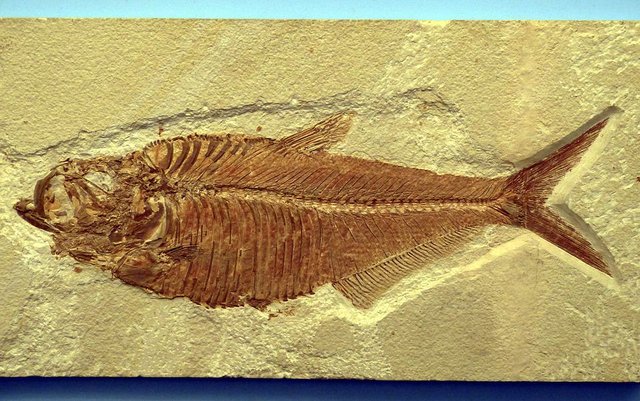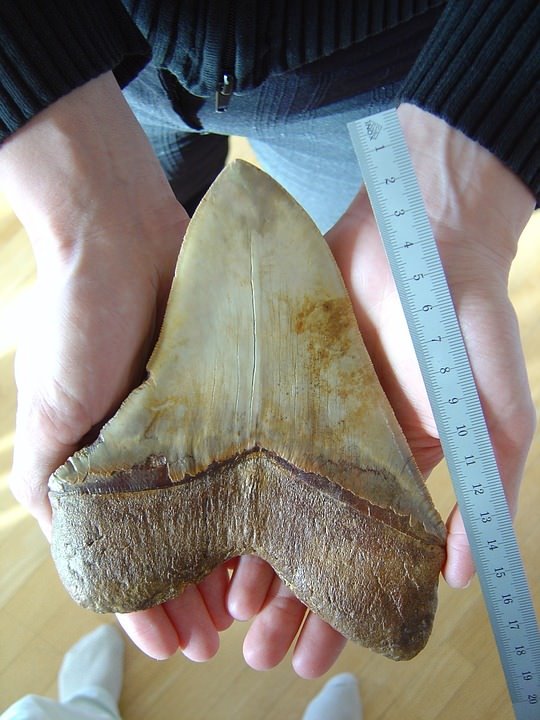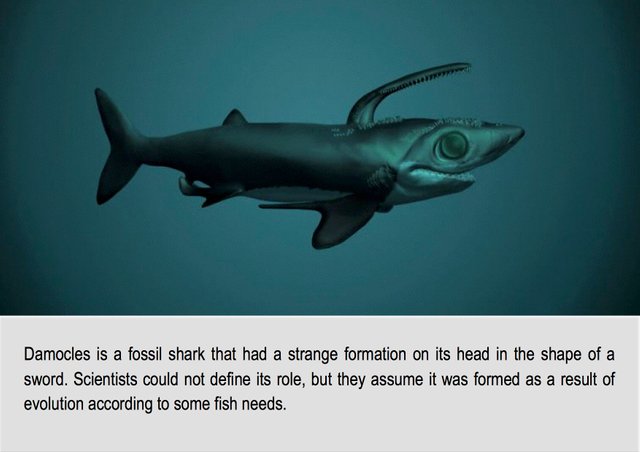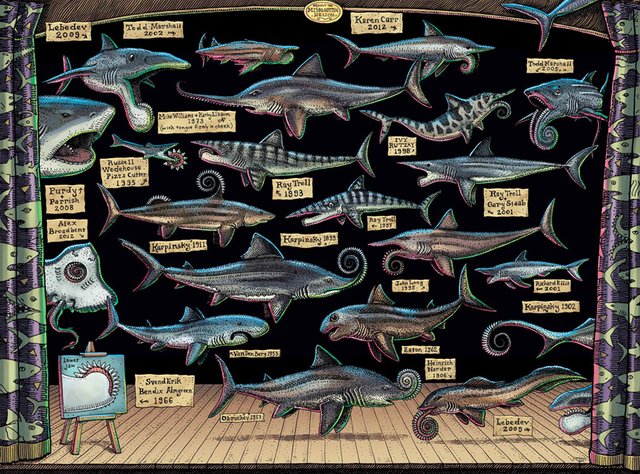How much are rays and sharks similar? What do we know about fossil sharks?
Today I will tell you about the difference between the three types of cartilaginous from each other at the molecular level, and also about how scientists study the extinct species of sharks by their fossil remains.
The course what the data is based on is called «Sharks! Global Biodiversity, Biology, and Conservation».
CHONDRICHTHYES
This class includes chimaeras, rays and, in fact, sharks. To understand how similar and different these species are, several hypotheses should be considered:
- Chimaeras are more similar to sharks than to rays.
- Sharks and rays are more similar to each other.
- Chimaeras are more similar to skates, rather than sharks.
- Lack of similarity in general between these species.
The table shows which characteristics are present and are absent in a particular species. And also it can be seen that the hypothesis number 2 is the closest to the truth: sharks and rays are more similar to each other. So at once you can not say immediately that these two species are very similar in structure, but it's true.
MOLECULAR DIFFERENCES
Technologies have made it possible to study the differences in animal species at the molecular level, that is, considering compounds of proteins and DNA, which means that there is a chance to see what is hidden to the unaided eye.
It is worth recalling that the protein sequences are composed of amino acids, which are threaded as pearls on a string. Between proteins there are enzymes to facilitate the flow of chemical reactions in cells.
Particular attention deserves the sequence of protein, which is part of an important enzyme in the body — cytochrome c-oxidase (Cox1). This enzyme acts as a transducer of nutrients into energy. In the body, billions of copies of it function, because with the disappearance of cytochrome c-oxidase organism dies.
In total, sharks have 20 amino acids forming proteins. The Cox1 molecule consists of 515 amino acid sequences. If we imagine that in the body of each shark there are 20,000 proteins, which, in turn, are formed from amino acids, it is easy to assume the obvious and not very different differences of the same protein for different species of fish. And in our case, when comparing proteins of chimaera, rays and sharks, it is clear that the former are akin to a group of rays and sharks whose protein sequences are identical.
Phylogenetics, Professor, Gavin Naylor talks about the evolution of sharks and studies them in detail by DNA. Recently he, along with Jason Davis, a programmer from London, created a website dedicated solely to sharks and rays, on which you can easily determine which species is related to which one, how they look and where they are found in the world.
Thanks to DNA analysis, Gavin collects a lot of information about fish organisms in the course of evolution. When studying extinct species, it is not easy to extract data on the basis of excavations and assumptions, and the older the animal, the more difficult it is to draw conclusions. One of the tasks of the scientist is to study the anatomy of the shark of the past, present and its prediction in the future.
FOSSIL SHARKS
Have you ever wondered how scientists study the remaining fossils of extinct animals, in particular sharks, to determine when they existed and when they died out? What are their hypotheses based on? These issues are dealt with by paleontologists and the research process is very difficult. The only method used by scientists is to compare the found fossils with living modern species of sharks.
Paleontologists distinguish the Phanerozoic time, which includes the Paleozoic, Mesozoic and Cenozoic periods. The first one is called "the era of ancient animals" (542-251 million years ago), the second is "the era of middle animals" (dinosaur period, which ended 65 million years ago), the third is "the era of modern animals."
Already during the Devonian period class of cartilaginous fish played an important role in the marine ecosystem. Further Paleozoic cataclysms resulted in mutations and extinctions of some species. The brightest period of sharks is the Jurassic one.
The Earth Museum in Ithaca (New York) contains a very interesting art work by Barbara Page, which created a mural with images of fauna representatives throughout history. The most interesting extinct species is megalodon,
this shark is also called a large white shark with huge teeth. And not surprising! Look at one of them.
In the US, there is a geologically valuable place Green River, which has preserved rare fossils. Their copies were created and out in the Museum of the Earth. In the waters of the lakes of this area many fish lived, as well as small freshwater stingrays, which are so well preserved that small cartilaginous connections are often seen in the remains.
Since the cartilage decomposes very quickly, only the teeth of sharks remain in the form of fossils and according to them scientists draw conclusions about the species, period of habitat, territory, etc. Transformation of the structure of sharks in the Carboniferous and Devonian periods was so significant that sharks of that time were significantly different from sharks of our era.
It is worth noting that in those days the sharks had a bone structure and not cartilaginous.
WHAT IS EXTINCTION?
Scientists claim that nature is always in balance, creating new species of animals and destroying others. In fact, several factors affect extinction, such as lack of food, inappropriate living conditions, diseases, climate change and so on. In the Phanerozoic times, the ratio of endangered species was 0.5 per thousand species per thousand years, but, in truth, there were certain time points in history when many species died out simultaneously, an example is the Cretaceous-Paleogene extinction.
According to data now, the percentage and rate of extinction of representatives of the animal world is 1000 times higher than ever in history, so scientists call this period "the sixth mass extinction".
WHAT REMAINS FOSSILIZE?
Cartilage tissues of sharks are easily damaged, so appropriate conditions are needed to make their residues become fossils. First, that no scavenger ate them. Secondly, the faster the residues are covered by sedimentary rocks (clay and limestone), the better they will be preserved, because they are blocked from oxygen and an anaerobic environment is created.
Here is how the artist Ray Troll portrayed the possible appearance of the helicoprion according to the fossils found and possible assumptions.
Screenshot from the course
I hope the information was interesting and useful. See you in my next post!
All pictures are under License CC0 if not indicated.





For more information, click here!!!!
The Minnowhelper team is still looking for investors (Minimum 10 SP), if you are interested in this, read the conditions of how to invest click here!!!
Excellent post - Up-Voted. Followed and Resteemed. Great Content here.
Thanks!
So many great posts. I like your name too !
And your Avatar !!!!
I am glad)
Oh, you are daisy as well, but not crazy)))
Resteemed by @resteembot! Good Luck!
Curious?
The @resteembot's introduction post
The @reblogger's introduction post
Get more from @resteembot with the #resteembotsentme initiative
Check out the great posts I already resteemed.
Great post. Follow me and Resteem @ SBD 0.001 by @jossylink
Congratulations @crazy-daisy, this post is the third most rewarded post (based on pending payouts) in the last 12 hours written by a User account holder (accounts that hold between 0.1 and 1.0 Mega Vests). The total number of posts by User account holders during this period was 2173 and the total pending payments to posts in this category was $1505.50. To see the full list of highest paid posts across all accounts categories, click here.
If you do not wish to receive these messages in future, please reply stop to this comment.